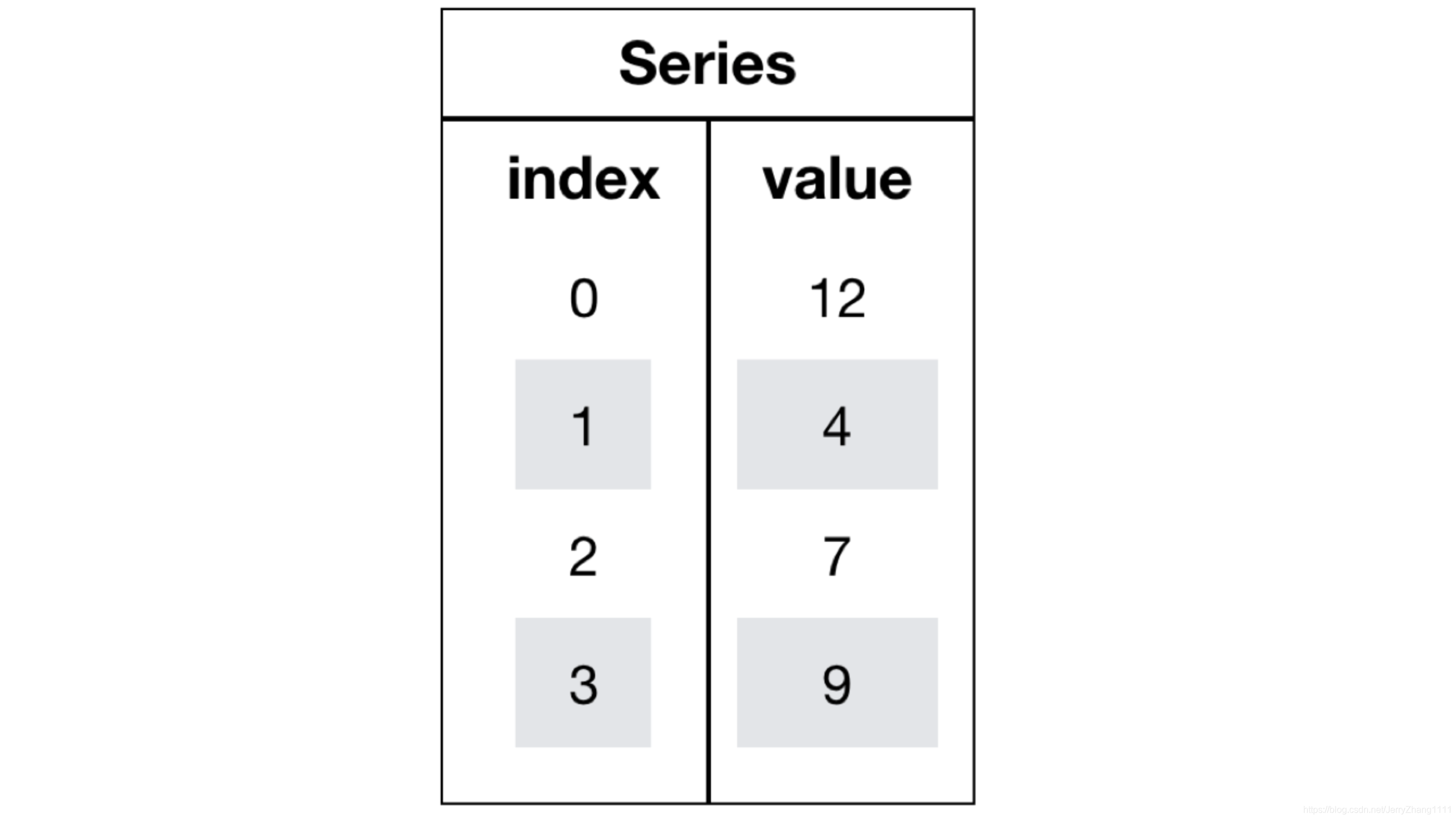Python機器學習三大件之二pandas
2008年WesMcKinney開發(fā)出的庫
專門用于數(shù)據(jù)挖掘的開源python庫
以Numpy為基礎(chǔ),借力Numpy模塊在計算方面性能高的優(yōu)勢
基于matplotlib,能夠簡便的畫圖
獨特的數(shù)據(jù)結(jié)構(gòu)
二、數(shù)據(jù)結(jié)構(gòu) Pandas中一共有三種數(shù)據(jù)結(jié)構(gòu),分別為:Series、DataFrame和MultiIndex。三、SeriesSeries是一個類似于一維數(shù)組的數(shù)據(jù)結(jié)構(gòu),它能夠保存任何類型的數(shù)據(jù),比如整數(shù)、字符串、浮點數(shù)等,主要由一組數(shù)據(jù)和與之相關(guān)的索引兩部分構(gòu)成。

import pandas as pdpd.Series(np.arange(3))
0 01 12 2dtype: int64
#指定索引pd.Series([6.7,5.6,3,10,2], index=[1,2,3,4,5])
1 6.72 5.63 3.04 10.05 2.0dtype: float64
#通過字典數(shù)據(jù)創(chuàng)建color_count = pd.Series({’red’:100, ’blue’:200, ’green’: 500, ’yellow’:1000})color_count
blue 200green 500red 100yellow 1000dtype: int64
Series的屬性color_count.indexcolor_count.values
也可以使用索引來獲取數(shù)據(jù):
color_count[2]
100
Series排序data[‘p_change’].sort_values(ascending=True) # 對值進行排序data[‘p_change’].sort_index() # 對索引進行排序#series排序時,只有一列,不需要參數(shù)
四、DataFrame創(chuàng)建
pd.DataFrame(np.random.randn(2,3))

score = np.random.randint(40, 100, (10, 5))score
array([[92, 55, 78, 50, 50],[71, 76, 50, 48, 96],[45, 84, 78, 51, 68],[81, 91, 56, 54, 76],[86, 66, 77, 67, 95],[46, 86, 56, 61, 99],[46, 95, 44, 46, 56],[80, 50, 45, 65, 57],[41, 93, 90, 41, 97],[65, 83, 57, 57, 40]])
但是這樣的數(shù)據(jù)形式很難看到存儲的是什么的樣的數(shù)據(jù),可讀性比較差!!
# 使用Pandas中的數(shù)據(jù)結(jié)構(gòu)score_df = pd.DataFrame(score)

data.shapedata.indexdata.columnsdata.valuesdata.Tdata.head(5)data.tail(5)data.reset_index(keys, drop=True)keys : 列索引名成或者列索引名稱的列表drop : boolean, default True.當做新的索引,刪除原來的列
dataframe基本數(shù)據(jù)操作data[‘open’][‘2018-02-27’] # 直接使用行列索引名字的方式(先列后行)data.loc[‘2018-02-27’:‘2018-02-22’, ‘open’] # 使用loc:只能指定行列索引的名字data.iloc[:3, :5 ]# 使用iloc可以通過索引的下標去獲取data.sort_values(by=“open”, ascending=True) #單個排序data.sort_values(by=[‘open’, ‘high’]) # 按照多個鍵進行排序data.sort_index() # 對索引進行排序
DataFrame運算
應用add等實現(xiàn)數(shù)據(jù)間的加、減法運算應用邏輯運算符號實現(xiàn)數(shù)據(jù)的邏輯篩選應用isin, query實現(xiàn)數(shù)據(jù)的篩選使用describe完成綜合統(tǒng)計使用max, min, mean, std完成統(tǒng)計計算使用idxmin、idxmax完成最大值最小值的索引使用cumsum等實現(xiàn)累計分析應用apply函數(shù)實現(xiàn)數(shù)據(jù)的自定義處理
五、pandas.DataFrame.plotDataFrame.plot(kind=‘line’)kind : str,需要繪制圖形的種類‘line’ : line plot (default)‘bar’ : vertical bar plot‘barh’ : horizontal bar plot關(guān)于“barh”的解釋:http://pandas.pydata.org/pandas-docs/stable/reference/api/pandas.DataFrame.plot.barh.html‘hist’ : histogram‘pie’ : pie plot‘scatter’ : scatter plot
六、缺失值處理isnull、notnull判斷是否存在缺失值np.any(pd.isnull(movie)) # 里面如果有一個缺失值,就返回Truenp.all(pd.notnull(movie)) # 里面如果有一個缺失值,就返回Falsedropna刪除np.nan標記的缺失值movie.dropna()fillna填充缺失值movie[i].fillna(value=movie[i].mean(), inplace=True)replace替換wis.replace(to_replace='?', value=np.NaN)
七、數(shù)據(jù)離散化p_change= data[’p_change’]# 自行分組,每組個數(shù)差不多qcut = pd.qcut(p_change, 10)# 計算分到每個組數(shù)據(jù)個數(shù)qcut.value_counts()
# 自己指定分組區(qū)間bins = [-100, -7, -5, -3, 0, 3, 5, 7, 100]p_counts = pd.cut(p_change, bins)
得出one-hot編碼矩陣
dummies = pd.get_dummies(p_counts, prefix='rise')#prefix:分組名字前綴八、數(shù)據(jù)合并
pd.concat([data1, data2], axis=1)按照行或列進行合并,axis=0為列索引,axis=1為行索引
pd.merge(left, right, how=‘inner’, on=None)
可以指定按照兩組數(shù)據(jù)的共同鍵值對合并或者左右各自left: DataFrameright: 另一個DataFrameon: 指定的共同鍵how:按照什么方式連接
九、交叉表與透視表交叉表:計算一列數(shù)據(jù)對于另外一列數(shù)據(jù)的分組個數(shù) 透視表:指定某一列對另一列的關(guān)系
#通過交叉表找尋兩列數(shù)據(jù)的關(guān)系count = pd.crosstab(data[’week’], data[’posi_neg’])#通過透視表,將整個過程變成更簡單一些data.pivot_table([’posi_neg’], index=’week’)十、數(shù)據(jù)聚合
count = starbucks.groupby([’Country’]).count()col.groupby([’color’])[’price1’].mean()#拋開聚合談分組,無意義
到此這篇關(guān)于Python機器學習三大件之二pandas的文章就介紹到這了,更多相關(guān)Python pandas內(nèi)容請搜索好吧啦網(wǎng)以前的文章或繼續(xù)瀏覽下面的相關(guān)文章希望大家以后多多支持好吧啦網(wǎng)!
相關(guān)文章:
1. WML的簡單例子及編輯、測試方法第1/2頁2. 前端html+css實現(xiàn)動態(tài)生日快樂代碼3. XML基本概念XPath、XSLT與XQuery函數(shù)介紹4. el-input無法輸入的問題和表單驗證失敗問題解決5. 關(guān)于html嵌入xml數(shù)據(jù)島如何穿過樹形結(jié)構(gòu)關(guān)系的問題6. CSS3實例分享之多重背景的實現(xiàn)(Multiple backgrounds)7. 不要在HTML中濫用div8. vue實現(xiàn)復制文字復制圖片實例詳解9. XML入門的常見問題(三)10. XML入門的常見問題(四)

 網(wǎng)公網(wǎng)安備
網(wǎng)公網(wǎng)安備